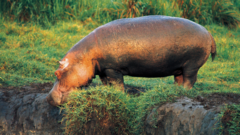At least 50 hippos and other large animals have tragically died from anthrax poisoning in Virunga National Park, the oldest national park in Africa, according to the park's director. Images shared by Virunga National Park in the Democratic Republic of Congo show the lifeless animals drifting along the Ishasha River, first spotted last week. While the exact cause remains undetermined, tests have confirmed the presence of anthrax.
Park director Emmanuel de Merode noted that efforts are underway to collect and properly bury the deceased animals to prevent further outbreaks, though the process has been complicated by logistical challenges and the unavailability of excavators. De Merode emphasized that limiting the spread is feasible using caustic soda for burial.
As the river flows north towards Lake Edward, additional reports of dead animals have emerged from local communities. Anthrax, caused by the bacteria Bacillus anthracis, can be lethal but generally does not disseminate easily, existing primarily as spores in the soil that may infect animals through inhalation or when entering cuts and wounds.
Authorities at the Congolese Institute for the Conservation of Nature have advised locals to avoid wildlife encounters and to boil water sourced from nearby areas before consumption. Covering an area of 7,800 square kilometers (3,000 square miles), Virunga Park is both wildly rich in biodiversity and plagued by danger. Despite being a favored tourist destination, the park has been adversely affected by ongoing conflicts between rebel factions and the Congolese army.
In recent years, armed groups have sought control over the region's valuable resources, leading to casualties among park rangers tasked with wildlife protection. The hippo population, which had previously plummeted from over 20,000 to merely a few hundred due to poaching and conflict, has seen conservation efforts in the past few decades aimed at boosting their numbers, making this incident particularly concerning.




















